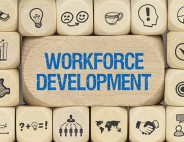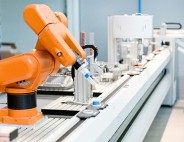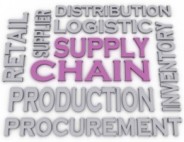Makers Create the Future
15 Jan, 2014
By Mark Kleszczewski
Are we on the verge of the next industrial revolution?
In an echo of the personal computer revolution, advancing technologies are fueling a growing “maker movement” of hobbyists, artists, designers, “do-it-yourselfers,” engineers and scientists who are sharing ideas and beginning to reshape the nature of 21st-century innovation and manufacturing.
It may be premature to declare the full arrival of the “next industrial revolution,” but the expanding availability of next-generation tools — ranging from 3D printers and robotics kits to “smart” materials and open–source prototyping platforms — combined with collaborations and partnerships, are showing huge potential in turning today’s tinkering into tomorrow’s economic growth.
Boosting the Creative Spirit
“Americans are very creative and industrious — we’ve always had inventors and tinkerers here,” says Debbie Holton, director of industry strategy and events, SME. “So it’s encouraging to see the maker movement nurturing that spirit and building a future pipeline of people who are going to be making all kinds of things. Additive manufacturing and 3D printing, in particular, are becoming a perfect kind of tangible outlet for individual design, especially at the consumer level.
“On the education side, what we’ve found is that young people and those who are new to the workforce are not necessarily opposed to a career in manufacturing,” Holton continues. “However, when they often hear about factories as being dark, dirty and dangerous, it’s usually based on what their parents think. So having young people and their parents exposed to and having fun making things is ultimately good for manufacturing.
“There’s a lot of folks with great ideas or projects they want to create, but just don’t know how or where to make them materialize,” Holton continues. “To move this forward, getting access to knowledge, resources and expertise is really important.”
Providing such resources and focusing a prominent spotlight on the movement are organized events like Maker Faire. Now in its eighth year since an initial start in San Mateo, Calif., the family-friendly gathering — sponsored by such partners as Disney, Ford, Motorola, MakerBot and others — has grown to more than 900 “makers” and more than 120,000 attendees in 2013, in California alone. Interest has been so high, the hands-on event has spread as far as Tokyo and Rome, with many community-driven, independently organized Mini Maker Faires also being produced across the United States and the world.
“The latest developments in 3D printers and other technology are giving us a new toolset to do things locally that perhaps we weren’t able to do in the past,” says Dale Dougherty, CEO, Maker Media, Inc. and co-founder of Maker Faire. “Just as we went from mainframe to personal and now mobile computing, we’re seeing a force of democratization at work that’s putting new tools and ways of doing things directly in the hands of people. Whether it’s customizing an object or making something that couldn’t have been made before, it doesn’t necessarily mean that everybody will now become a manufacturer, but it’s still transformative.”
One of the main things communities can do to support local makerspaces at this stage is to first understand and define the activity, especially in terms of zoning, Dougherty suggests. For example, a city’s economic development arm may be trying to organize or support an emerging space or maker group, yet in the very same city there may be inspectors who are trying to shut it down because they don’t quite understand whether they’re dealing with a public meeting space or a light industrial facility.
Big Companies Join the Crowd
“The power of individual ideas, people making things together and crowdsourcing of innovation is definitely going to be a future manufacturing trend and a pretty powerful thing for companies willing to utilize it,” Holton says.
One of the most notable industry leaders connecting to the maker culture of openness in a tangible way is GE, which has taken its “GE Garages” concept — originally a one-off “fab lab” event unveiled at SXSW in Austin, Texas, two years ago — and turned it into a skill-building center and advanced manufacturing lab for technologists, entrepreneurs and everyday Americans.
Developed in partnership with TechShop, Skillshare, Quirky, Make and Inventables, the traveling innovation and manufacturing center aims to spark interest and engagement from prototyping inventions to modern manufacturing-based technologies through special classes and hands-on experiences with 3D printers, CNC mills, Arduino kits, a laser cutter and an injection molder.
“Advanced manufacturing and innovation is critical to GE, so this is an important activity for us,” says Linda Boff, executive director, global brand marketing, GE. “We’re proud of our technologies and the work we do, but you can’t just walk into a GE lab. So this is a great way for us to throw open the doors and invite people in. To be able to engage with students, businesspeople, technologists and show them a side of GE that they may not normally have an opportunity to interact with, is just a wonderful way to bring the company to life.
“Chicago Ideas Week in September was a tremendous success for GE Garages, and we’re now looking at not just continuing it next year, but even going global in several locations outside the U.S.,” Boff continues.
Cooperative Manufacturing Scales Up
Bringing makers together is a priority for TechShop, a growing member-based community and network of facilities that are part fabrication and prototyping studio, part “hackerspace” and part learning center. For aspiring “DIY” makers, TechShop provides access to more than $1 million worth of software and professional resources which include laser and waterjet cutters, welding stations, plastics and electronics labs, a machine shop, a wood shop, a metalworking shop and a textiles department.
While spaces like TechShop are really taking off, early-stage entrepreneurs who still want to collaborate but need access to specialized equipment on a regular, production-level basis will need something more, Dougherty notes. In addition, he says, we’re seeing a rediscovery and return of manufacturing back to urban areas, creating a demand for industrial space after decades of being pushed out to the suburbs and overseas.
One of the most high-profile places taking such cooperative manufacturing to the next level is the city of New York’s Brooklyn Navy Yard, whose NewLab initiative allows businesses to design and create products in a communal setting.
Backed by about $60 million in public and private investment, NewLab’s developer Macro Sea is transforming 84,000 square feet of space into a high-tech design and prototyping center that will become a national model for sustainable industrial parks. What was once a facility for building state-of-the-art ships will become a cutting-edge center that incubates and encourages new manufacturing. Entrepreneurs, educators, and businesses in disciplines ranging from additive manufacturing, biotech, advanced robotics, architecture and industrial design will work alongside one another in NewLab’s unique space.
“Urban manufacturing has always been alive and thriving in the Brooklyn Navy Yard, but the maker subculture has helped to make it even more accessible for individual artisans or designers to bring their concept to life,” says Aisha Glover, vice president of external affairs, Brooklyn Navy Yard Development Corp. “For the yard, that means an even greater demand for light industrial space that is hard to come by in the city.”
With a primary goal of nurturing the next generation of innovators and entrepreneurs, Glover adds the time was right for her organization and other stakeholders to invest in and operate this kind of facility, because demand is there and the potential for job creation is imminent. She reports that the current “beta” version of the manufacturing hub has been fully leased up in anticipation of Building 128 coming online and expects to have all the new space fully occupied by Q2 2015.
Fabricating the Future
As physical and digital technologies converge and the maker movement and cooperative manufacturing spread, they’re not just making products, they’re also making vibrant communities of global problem-solvers that may lead to new areas of industry and economic opportunity.
“In previous generations, many people who ended up in manufacturing got started in their garage, working on their cars,” Holton says. “Unfortunately, we got to a point where you couldn’t do that very easily anymore. Whether it’s in a garage, a shared space or in a small business, the idea of people today wanting to make things again is good news for manufacturing and the economy in the long term. Not all of those people will necessarily become the next Steve Jobs, but a percentage are going to make big things out of their ideas.”
“We don’t know yet where this is all going, but neither did the people who began building textile mills know that they were part of a revolution — they just saw that there was a new and better way to do things, so they did it,” Dougherty says. “Today, it’s almost like we’re seeing a meeting in the middle between the handcrafted era and the industrial age. So it’s exciting to see how this will play out not just in manufacturing, but what creators, inventors, makers and producers will do across a lot of different fields.”
Mark Kleszczewski is president and CEO of GoBusiness Group, LLC and a freelance writer on critical business topics. He can be reached at mark@gobusinessgroup.net.
Illustration by GE Garages, www.ge.com
For complete details on the organizations featured in this article, visit:
Brooklyn Navy Yard Development Corp.
Related Posts
-

Development in Transition
-

Advanced MFG
-

Advanced Manufacturing Now in Every Industry Sector
-

Reshoring Essential to Manufacturing’s Renaissance
-

Manufacturing: Growth and Reshoring Shape 2015
-

Manufacturers Take Sustainability to New Levels
-

What does Manufacturing Mean to You? Video
-

Building the Future of Manufacturing
-

Chicago is Overcoming Manufacturing’s Deeper Problem
-

Manufacturing: Welcome Back to the USA









